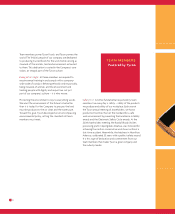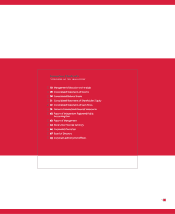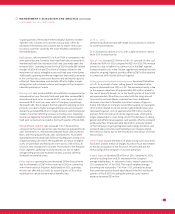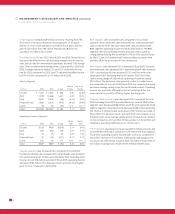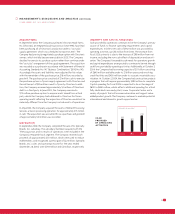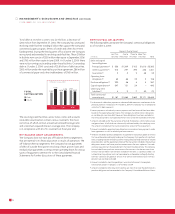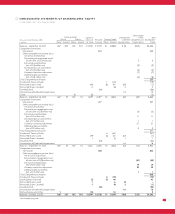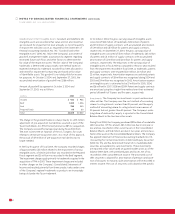Tyson Foods 2004 Annual Report Download - page 26
Download and view the complete annual report
Please find page 26 of the 2004 Tyson Foods annual report below. You can navigate through the pages in the report by either clicking on the pages listed below, or by using the keyword search tool below to find specific information within the annual report.
24
MANAGEMENT’S DISCUSSION AND ANALYSIS (CONTINUED)
Total debt at October 2, 2004, was $3.4 billion, a decrease of
$242 million from September 27, 2003. The Company has unsecured
revolving credit facilities totaling $1 billion that support the Company’s
commercial paper program, letters of credit and other short-term
funding needs. During the third quarter of fiscal 2004, the Company
restructured and extended its revolving credit facilities. These $1 billion
in facilities now consist of $250 million that expire in September 2006
and $750 million that expire in June 2009. At October 2, 2004, there
were no borrowings outstanding under these facilities. Outstanding
debt at October 2, 2004, consisted of $2.8 billion of debt securities,
$300 million under the receivables purchase agreement, $86 million
of commercial paper and other indebtedness of $160 million.
The revolving credit facilities, senior notes, notes and accounts
receivable securitization contain various covenants, the more
restrictive of which contain a maximum allowed leverage ratio
and a minimum required interest coverage ratio. The Company
is in compliance with all of its covenants at fiscal year end.
The Company does not have any off-balance sheet arrangements
that are material to its financial position or results of operations. The
off-balance sheet arrangements the Company has are guarantees
of debt of outside third parties involving a lease, grower loans and
residual value guarantees covering certain operating leases for various
types of equipment. See Note 10 to the Consolidated Financial
Statements for further discussions of these guarantees.
The following table summarizes the Company’s contractual obligations
as of October 2, 2004:
Payments Due by Period
Less Than One to Three to More Than
in millions One Year Three Years Five Years Five Years Total
Debt and capital
lease obligations:
Principal payments(1) $ 338 $1,309 $105 $1,610 $3,362
Interest payments(2) 213 297 295 456 1,261
Guarantees(3) 2324855
Operating lease
obligations(4) 63 68 25 2 158
Purchase obligations(5) 220 58 4 5 287
Capital expenditures(6) 347 121 24 – 492
Other long-term
liabilities(7) 4975070
Total contractual
commitments $1,187 $1,865 $462 $2,171 $5,685
(1) In the event of a default on payment or violation of debt covenants, acceleration of the
principal payments would occur. At October 2, 2004, the Company was in compliance
with all of its debt covenants.
(2) Interest payments include only interest payments on fixed-rate and fixed-term debt,
based on the expected payment dates. The Company has other interest obligations
on variable-rate, non-term debt; however, these obligations have been excluded, as
the timing of payments and expected interest rates cannot be reasonably estimated.
(3) Amounts included are for the guarantees of outside third parties, which involve a lease
and grower loans, all of which are substantially collateralized by the underlying assets.
The amounts included are the maximum potential amount of future payments.
(4) Amounts included in operating lease obligations are minimum lease payments under
lease agreements, as well as residual guarantee amounts.
(5) Amounts included in purchase obligations are agreements to purchase goods or services
that are enforceable and legally binding on the Company that specifies all significant
terms, including: fixed or minimum quantities to be purchased; fixed, minimum or variable
price provisions; and the approximate timing of the transaction. Included in the purchase
obligations amount are future purchase commitments for corn, soybeans, livestock
and natural gas contracts that provide terms that meet the above criteria. The Company
has excluded future purchase commitments for contracts that do not meet these
criteria. Purchase orders have not been included in the table, as a purchase order is an
authorization to purchase and is not considered an enforceable and legally binding
contract. Contracts for goods or services that contain termination clauses without
penalty have also been excluded.
(6) Amounts included in capital expenditures are estimated amounts to complete
construction projects in progress as of October 2, 2004.
(7) Amounts included in other long-term liabilities are items that meet the definition of a
purchase obligation and are recorded in the Company’s Consolidated Balance Sheets.
TOTAL
CAPITALIZATION
Debt
■Equity
DOLLARS IN MILLIONS
3,662
3,954
4,292
3,362 3,604 3,987
2004 2003 2002


